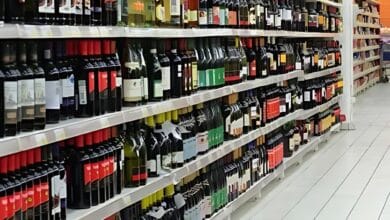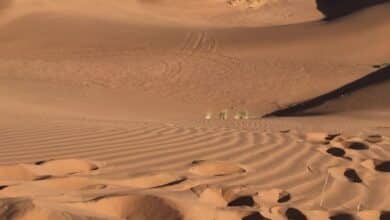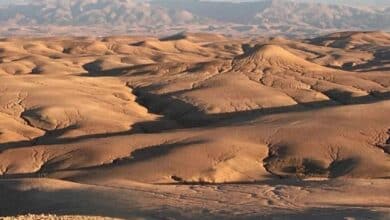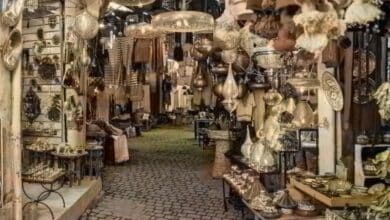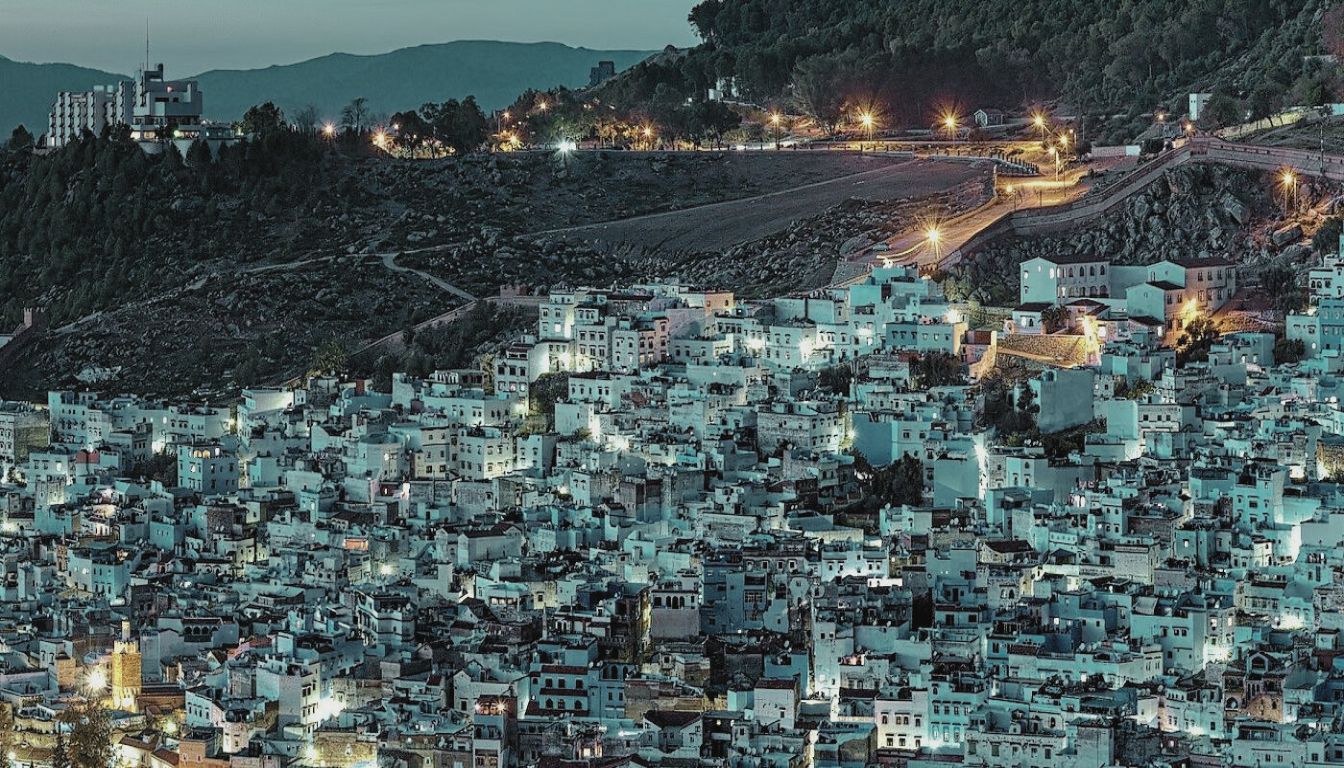
Discover Chefchaouen, the Blue Pearl of Morocco.
Chefchaouen, a city of 40,000 inhabitants, has been famous since the 1990s. It is hidden in the Rif Mountains. Its particular charm comes from its blue streets and its 500-year history.
This place is also called “Chaouen Morocco” and is great for photography. The blue houses and local crafts like rugs and pottery are unique. This makes the memories even more special.
From Tangier, Fez, or Rabat, you can easily reach Chefchaouen. There, you’ll find unique activities. For example, women offer to have their photos taken in traditional northern clothing for 10 Dh.
Why is Chefchaouen called “the blue pearl”?
Chefchaouen is often nicknamed the Blue Pearl of Morocco . The mountains surrounding it demonstrate why. Located between Kelaa and Meggou in the Rif Mountains, it is 600 meters above sea level. The town is famous for its blue buildings. This blue has been everywhere for about twenty years. Locals paint the walls blue every spring.
This gives Chefchaouen the appearance of semi-precious stones. One thinks of amethyst or turquoise when seeing its colors.
This blue city in Morocco is known for much more than its blue houses. It boasts a rich cultural and natural heritage. In 2010, Chefchaouen became a UNESCO World Heritage Site. This was thanks to its adoption of the “Mediterranean Diet.” This balanced diet is based on foods like olive oil and fruits.
Morocco’s Blue City is clean and well-maintained. It’s a source of great pride for its residents. The blue walls aren’t there just for beauty. They recall an act of Jewish solidarity from the 1930s. Jewish refugees fleeing the Nazis painted them that way. They symbolize hope and spirituality.
Chefchaouen, also known as Blue Morocco , is a peaceful place. It’s a popular tourist destination. In addition to its blue houses, the city is rich in religious sites. There are mosques, zaouias (holy sites), and mausoleums. All of this makes the visitor experience more authentic.
Visit the medina of Chefchaouen
Chefchaouen’s medina, or xauen , enchants with its narrow streets and white houses. Designed in the 15th century, it blends Andalusian and Moorish architectural styles. The famous blue walls attract photography enthusiasts from all over the world.
Exploring the Chefchaouen medina offers a unique experience to learn about its history. A two-hour walk allows you to experience the special atmosphere of this place. It’s like diving into the heart of Moroccan culture and discovering its secrets.
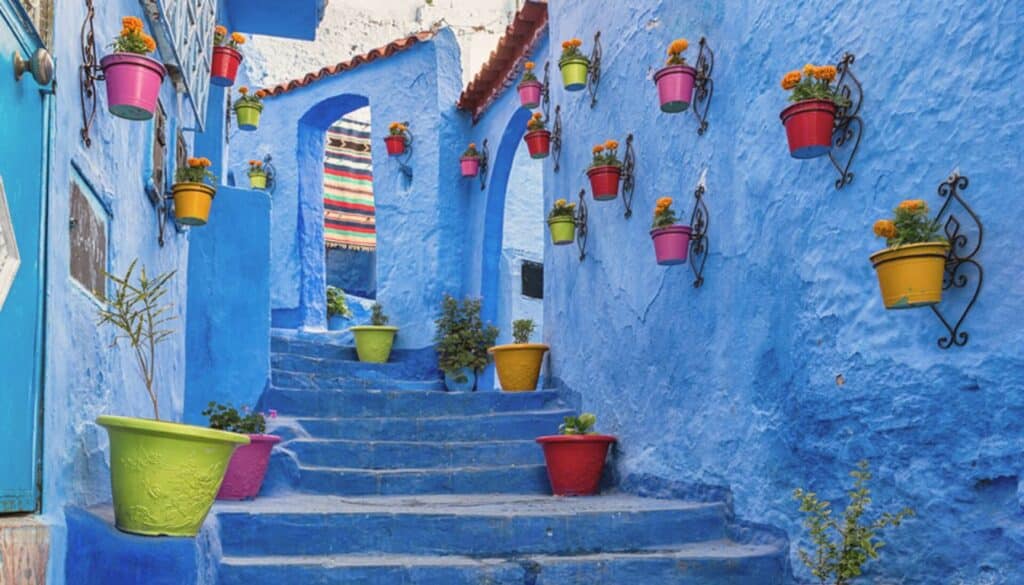
El Haouta Square
El Haouta Square, located in the heart of the medina, is a major landmark. With its fountain and impressive gates, it tells the story of the Xauen . This square offers a relaxing setting to admire local traditions while overlooking the beauty of the medina.
Discovery of the Kasbah
The Chefchaouen Kasbah immerses you in the history of Chefchaouen . It is a 15th-century fortress. It demonstrates the importance of Chefchaouen in defending the region at the time.
It divides the medina in two and showcases Moroccan culture . Its walls and towers are impressive. Admission costs 60 dirhams and a visit lasts 30 to 45 minutes.
Ethnographic Museum
The Ethnographic Museum is located in the kasbah. It displays traditional objects, crafts, and ancient agricultural tools. Each object tells a part of Chefchaouen’s history .
This helps you understand local life and customs. You will better understand Moroccan culture.
Portuguese Tower
The Portuguese Tower dominates the city. It was built to protect the city. Today, it offers a superb view.
Walking around this tower brings its heroic history to life. The landscapes are magnificent.
The Spanish Bouzafar Mosque
The Bouzafar Mosque has stood on a hill overlooking the city of Chefchaouen since 1928. This was when Spain had just colonized the region. The Spanish called it “Sidi Walo,” but many locals did not come there.
In 2007, Chefchaouen City Hall began restoring the mosque and its surroundings. Today, it is a popular tourist attraction, offering a beautiful view of the city.
This mosque is very special, with a rich history. It offers a magnificent view of the blue city of Chefchaouen, thus remaining a major attraction.
Panoramic view
There’s more to see than just a mosque. From the top, you can admire a superb panorama of Chefchaouen . You can see the blue roofs of the city and the Rif Mountains.
The view, magnificent at any time of day, is incredible at sunset. It’s a true natural spectacle.
The Akchour waterfalls
The Akchour Waterfalls are located 45 minutes from Chefchaouen. They offer an exploration of the Rif wilderness via beautiful hikes. The trails reveal natural pools and magnificent landscapes. It all culminates in the impressive Akchour Waterfalls, a truly incredible sight. These waterfalls bring a place of great beauty to life.
Hiking
Hiking to the Akchour Waterfalls is an adventure not to be missed. The trail is 5.5 km long, well-marked, and offers stunning views. This hike takes between 3 and 4 hours. You’ll cross wooden bridges and river crossings, inviting you to connect with nature.
If you’re looking for an extra challenge, hike up to the upper Akchour Falls, which are about 100 meters high. The return trip takes about 75 minutes. A slower hike can take up to 2-3 hours. Note that the waterfall’s flow can decrease in summer, so the best time is late spring after the winter rains.
It is recommended to bring 2 liters of water per person. You will need comfortable walking shoes, a waterproof jacket in winter, and swimwear in summer. Don’t forget snacks. These items are essential to fully enjoy your day. They will help you explore the magnificent rivers and waterfalls of Akchour.
Crafts and souks of Chefchaouen
Chefchaouen, a city in the Rif Mountains, is famous for its unique Moroccan craftsmanship . This art has been passed down from generation to generation. In Chefchaouen’s souks, such as Souk El Haouta, you can find many handmade items. There are Berber rugs, silver jewelry, and much more. Not to mention hand-dyed wool items and pottery with Berber designs.
Berber rugs are highly prized for their unique patterns. Made by local artisans, they bring a special beauty to every home. Leather goods, pottery, and handmade textiles can also be found in the markets. All of this demonstrates the skill of Moroccan artisans.
Chefchaouen’s souks showcase artisans at work. Here, you can observe ancient techniques using local materials. It’s an ideal place to find special gifts and immerse yourself in the tradition of Moroccan craftsmanship. It’s also an opportunity to support local artisans while appreciating their work.
Conclusion
Chefchaouen is magical with its winding streets and blue houses. This city was founded in 1471 by Moulay Ali ibn Rashid al-Alami. It is a treasure trove for Morocco, showcasing its roots in architecture and decoration. These influences, coming from Andalusia via Spain, are evident everywhere.
Chefchaouen’s unique blue color comes from the history of the Jews who lived there after fleeing Nazism. The old quarter tells this intense story, as does the Kasbah. The Ethnographic Museum and the Spanish Mosque reveal different faces of this exceptional city.
Discovering Chefchaouen also means enjoying incredible views of the Rif Mountains. Hiking and mountain biking are possible thanks to the perfect climate. The shops and souks offer local treasures of Moroccan crafts. With its varied accommodation options and activities, Chefchaouen epitomizes the beauty of Morocco.

